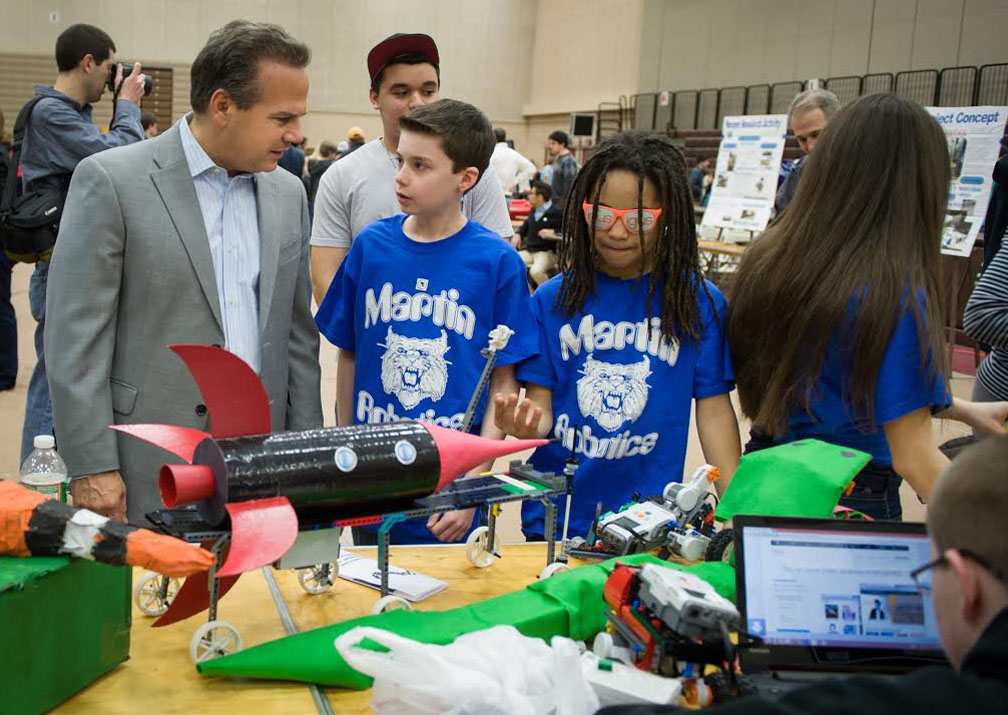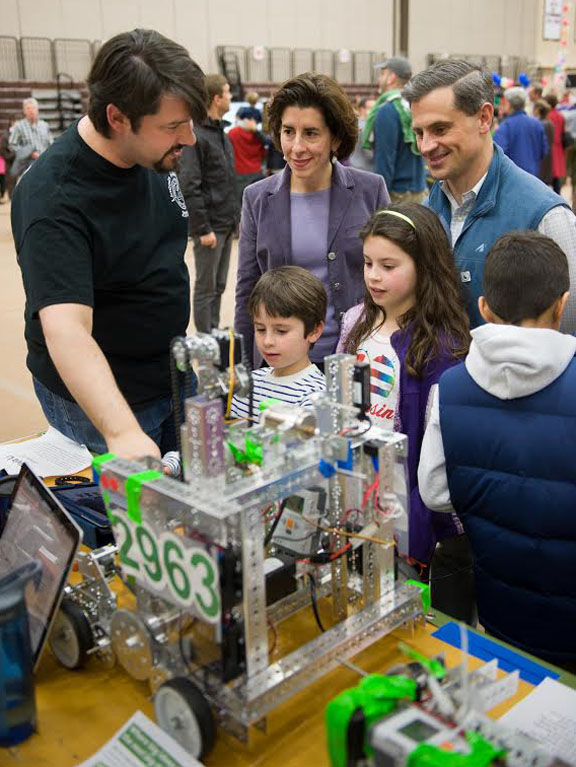PROVIDENCE, R.I. [Brown University] — On Saturday, April 5, 2014, robots took over the basketball arena at Brown’s Pizzitola Sports Center.
It wasn’t a hostile takeover, however. It was a party.
Rhode Island’s first Robot Block Party showcased state-of-the-art robotic technology being used and developed in the Ocean State. Robots roamed the floor, mingled with the crowd, and gave high-fives and hugs — all to the delight of more than 1,800 guests who came from around Rhode Island and beyond to learn about robotic technology.
The event was part of National Robotics Week, an effort to bring attention to robotic technology emerging across the county. The Rhode Island event featured exhibits by universities, companies, and student groups from around the state.

Brown roboticists brought two robots — PR2 and Baxter — as well as quadricopter drones and a telepresence device. The University of Rhode Island showed off robotic kayaks and buoys used for oceanographic research on Narragansett Bay. Igus, a Rhode Island-based manufacturer, displayed the robotic technologies used in a variety of manufacturing settings. Elementary, middle- and high-school students demonstrated robots they built for robotics competitions and after-school programs. A total of 45 exhibitors took part in the 5-hour event.
Sam Torres, a 10-year-old from Mansfield, Mass., was particularly impressed with the PR2, which is in use at Brown in the lab of Chad Jenkins, associate professor of computer science and engineering.
“It was very lifelike and looked like it had a lot of computing power,” Torres said, after a high-five and a fist-bump with the robot. “It looks like someday it could really help people out with house needs.”

Torres said he wants to be a roboticist himself when he grows up. He asked Tom Sgouros, a researcher in Jenkins’ lab, what it takes to have a job working with robots like the PR2.
“He said I need to study math and science. [Those are] my two favorite subjects!” Torres said with a broadening smile.
Interactions like that between robot, roboticists, and the next generation of robotics pioneers are the whole point of the event, said Mary Johnson, executive director of Rhode Island School of the Future, a Providence-based nonprofit organization. “It gives kids a sense of college major or career choices they could aspire to,” she said. “And it helps the community understand what the future of robotics could hold.”
Rhode Island School of the Future sponsored the event with Brown University’s Humanity-Centered Robotics Initiative (HCRI). HCRI is a group of Brown faculty and students who aim to understand the ways in which society can benefit from further development of robotics.
“I think we’re starting to get a sense of what’s possible in Rhode Island,” said Jenkins, one of the leaders of HCRI. “I look around and I see everybody from elementary schools to universities to companies from around the state. You don’t have to be in Silicon Valley or Boston to have a hub of robotics. You definitely get a sense that there’s something going on here that’s larger than just the sum of its pieces.”
Among the younger presenters were Danielle and Jordan Durfee, sisters from Riverside, R.I. They each showed off Lego robots they built as part of a robotics class at Riverside Middle School. Danielle’s was Jawz, a robotic snake programmed to lunge when objects cross its motion-sensing eyes. Jordan built a sled pulled by two small robotic dogs.
“I like robotics because it’s challenging,” Jordan said. “If it doesn’t work, you have to figure out what’s wrong with it, and I love challenges.”

“I think it’s really fun doing this,” Danielle added. “Kids should do it more.”
Jenkins agrees. Part of the mission of HCRI is to expose as many people as possible — young and old — to emerging robotic technologies.
“Not everybody is going to be a roboticist, but as these technologies develop, we’ll all be using them,” Jenkins said. “We want to familiarize people with what robots can do to better society — improving care for the disabled, improving the way we educate people, creating new jobs — so that as many people as possible have a hand in guiding how robots will be used in the future.”
